“Absorb what is useful. Discard what is not. Add what is uniquely your own.” – Bruce Lee
I’ve felt lucky to learn so much from being an avid reader in the past few years. I’ve come to believe that there is such immense power and knowledge contained within books.
As a natural introvert, I’m a reflective person and love to read books and think about what we could try to apply at Buffer.
In fact, we’re such believers in the power of reading at Buffer that all new team members (and family members) receive a Kindle with unlimited Kindle books (of any type, no questions asked).
Something I have done with books in the past is get about 30 to 40 percent through and get really excited to start implementing things.
I think this might be because with a startup, you often have to get comfortable acting without complete information. For example, when we do customer development we’ll never validate an idea or thought 100%. There’s always a leap we have to take.
But with our reading on leadership, I’ve realized that we could improve this and be a little more grounded in the decisions we make.
Here’s the story of two recent books that have had a big impact on our team, and how Buffer changed with each one based on what we read.
Reinventing Organizations: The book that changed Buffer’s direction
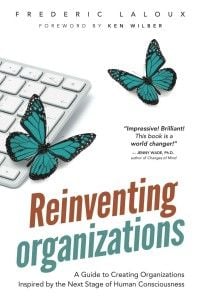
One night in late 2014, I stayed up until 4 a.m. reading the book Reinventing Organizations.
It was one of the most exciting books I had ever read, and I couldn’t wait to see how it would impact Buffer.
When I was through with the book, I was so inspired I wrote this letter to the author, Frederic Laloux.
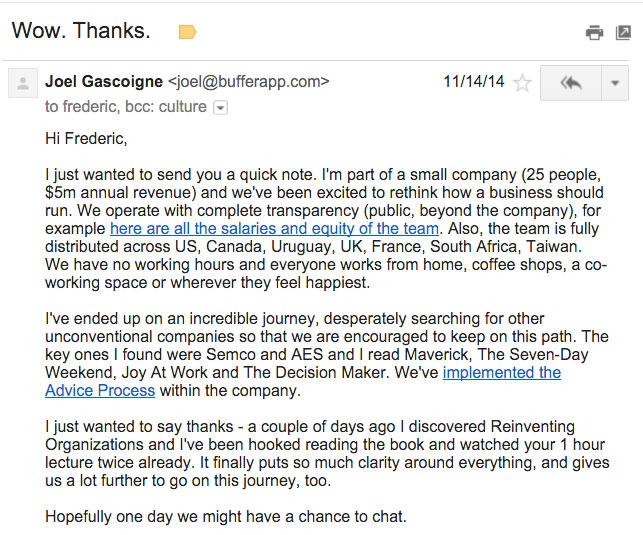
(Frederic and I did eventually get an opportunity to chat, and I’m so grateful to him for his time and the incredible book.)
Eventually, Reinventing Organizations would be read by almost all the people within the Buffer team, and transform how the company operated in many ways.
Here’s the note I sent to the team that sent us on a fascinating self-management journey through most of 2015:
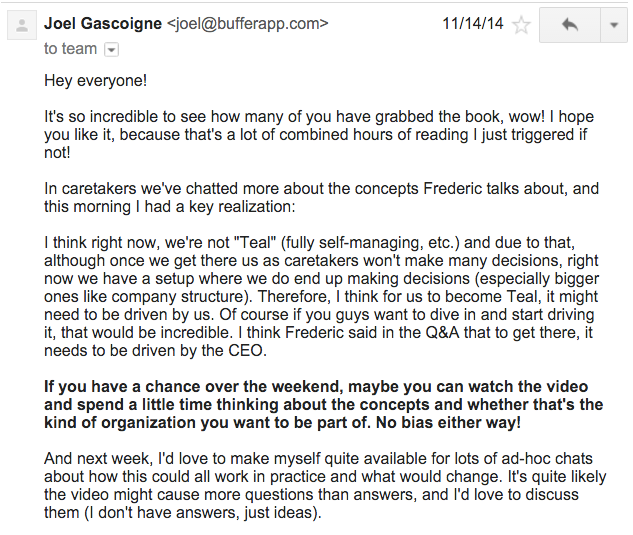
We made a lot of changes, including dropping all titles, stopping all official coaching and mentorship, and letting each teammate choose the goals and projects they wanted to work on (and what they wanted to pay themselves). On the marketing side, we tried to create a marketing plan without any goals.
Fast forward to present day: We’re grateful for the element of wholeness that Reinventing Organizations brought us and have moved away from its ideas in other ways, bringing back mentorship, goals and metrics.
We interpreted Teal as completely loose: the chaos, the forest. We threw out the ideas of management, skills, leadership, experience. Those are some of the things that we got wrong.
I think it was a great learning experience; it did set us back.
High Output Management: A more balanced approach
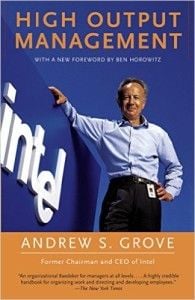
By the time I came across the underground business classic High Output Management by former Intel CEO Andy Grove this year, I knew we want to get away from the pattern of reading one book and changing everything as a result.
After I discovered and read High Output Management, I knew I wanted to introduce it to others on the team, but in a different way.
This time, it felt important to share the thought that while there’s lot of great stuff in it, a lot of what it describes is also pretty far from what we want to have. (It was published in 1983, when things were a lot different in the business world!)
As a small but important example, I prefer not to call employees “subordinates” as Grove does—or even employees, for that matter. “Teammates” has been a great fit for us at Buffer.
I didn’t want High Output Management be our next “book” but I did want to take what we could from it.
A tipping point for us in valuing “people management” came from came from High Output Management, as did the idea of “task relevant maturity”—relating how many touchpoints a person needs in a task to their familiarity with the task:
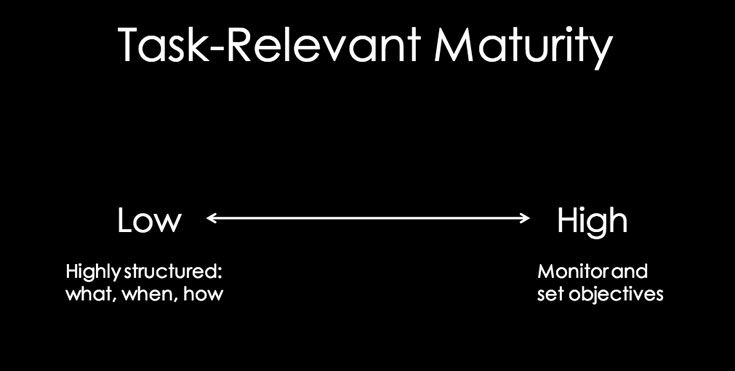
These are both really useful concepts for us.
Additionally, High Output Management evolved our one-on-ones and accelerated how we think about and plan for leadership at Buffer, which is important.
My experience when I read High Output Management was very different than that of reading Reinventing Organizations.
In fact, as I could feel the book moving us further away from elements of self-management I made sure to cue up a Ricardo Semler TED talk on running a company with no rules to make sure to hear the “other side,” too.
My lesson: Be thoughtful in how I embrace new ideas
There’s a certain power in embracing an idea completely and fully giving yourself over to it.
At the same time, I’m finding it increasingly important to apply a lot of critical thinking and hear out an idea from all sides.
This learning reminds me of Jim Collins’ “bullets before cannonballs” blog post, where he advises validating with smaller steps (bullets) first during challenging times, instead of immediately looking for “big solutions, giant leaps, and dramatic success” (cannonballs).
“Wise leaders test idea and assumptions in low risk, low cost way. Try something in a small way and brutally evaluate when it’s over.”
I believe there is still room with our new, more grounded approach to experiment with structuring the team, decision-making, and management processes.
The biggest lesson I’ve learned is to be really thoughtful about how we do this, and to validate ideas to the appropriate level before rolling them out to the whole team. The bigger the company gets, the bigger the impact of each experiment becomes.
I’m excited to keep reading and learning from what others are trying with various management structures. And yet as soon as we start going pretty far in one direction, we want to start getting opposing thoughts.
The good news is, the more we read, the more context we will naturally have.
The 10 books of Buffer (right now)

Today we’re reading as widely as we can, trying different things and keeping whatever works.
We’ve taken bits and pieces from countless management books, and we’re growing a bit more confident in our mix-and-match style.
Buffer’s management at the moment is a mix of:
- The Decision Maker: Most teammates at Buffer have read this fable by Dennis Bakke. It has helped to shape our ideas of complete trust and confidence in each team member to have the right context to make great decisions.
- Joy at Work: We hope we can retain some of the ideas from Dennis Bakke’s organization AES, and create management that’s a bit different.
- High Output Management: The way we view leadership, feedback, and one-on-ones has been heavily influenced by this book by Andy Groves.
- Reinventing Organizations: The biggest element of this book by Frederic Laloux that we’ve kept is the idea of bringing your “whole self” to work.
- The Seven-Day Weekend: Changing the Way Work Works: I mentioned Ricardo Semler’s TED talk earlier, and this book is another piece that has helped to shape Buffer. Some of Semler’s ideas are so radical it makes me question everything I think I know about work.
- Maverick: Another book by Ricardo Semler; this one helped to reinforce our confidence in many of our budding cultural ideas, like the value of transparency, and having trust in teammates to choose their location and work hours.
- Good to Great: This Jim Collins book helped me to understand how important culture is for building a great, lasting company that has an impact on the world. It helped me to understand that culture can be crafted by choice rather than rather than simply observed.
- Five Dysfunctions of a Team: I read this book at a key point when we were discovering that we needed to put our values into words to shape the culture of Buffer. The book helped to clarify that through culture, provided we lived it, we could get to the deepest levels of trust with one another and enable much better teamwork within the company.
- The 7 Habits of Highly Effective People: The Buffer value of ‘Listen first, then listen more’ comes almost directly from Habit 5 of this bestselling classic.
- How to Win Friends and Influence People: Perhaps the most foundational book of Buffer. We have based a large number of the values within the Buffer culture directly on the principles Dale Carnegie proposes here.
I’m personally inspired by all of these books and lots more.
There’s no one-size-fits-all book for building a company—any company.
I’m sure in the future I’ll discover many new books and ideas that make me want to change everything.
I hope I can remember the lessons I’ve reflected on here and make a balanced decision.
What about you—how do achieve balance when you’ve discovered a new idea or solution? What keeps you from going too far in any one direction?
Try Buffer for free
190,000+ creators, small businesses, and marketers use Buffer to grow their audiences every month.



